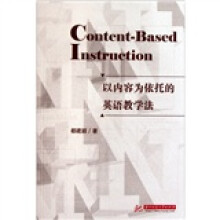Background
Introduction
Chapter 1 Conceptualising CBI
1.1 Definitions of CBI from a diversity of aspects
1. l. 1 A functional linguistic view of CBI
1.1.2 A pedagogical aspect of CBI
1.1.3 CBI as subset of integrated language and
eontent teaching
1.2 Characteristics of GBI
1.2.1 Subject-matter eore
1.2.2 Authentic language and texts
1.2.3 Focus on specific needs of specific student groups
1.3 Towards a definition
1.3.1 Content-language integrated instruction(CLII)
as the ideal form of CBI
1.3.2 Content-based language instruction (CBLI)
as the weak form of CBI
1.3.3 Language-based content instruction (LBCI)
as the strong form of CBI
1.4 Contextualizing CBI in EFL settings
Chapter 2 Relationship Between CBI, EAP and
Other Language Teaching Approaches
2.1 CBI and EAP:the link and differences
2.1.1 CBI as an approach to EAP
2.1.2 CBI as extension of EAP
2.1.3 Common ground between CBI and EAP
2.1.4 Differences between EAP and CBI
2.2 Distinguishing CBI from other approaches and
methodologies
2.2.1 Differentiating CBI from L2 content teaching
2.2.2 Differentiating CBI from bilingual education
2.2.3 CBI and the grammar-translation approach
2.2.4 CBI and the task-based approach
Chapter 3 Theoretical and Practical Supports for CBI
3.1 Theoretical support for CBI
3.1.1 Krashen's comprehensible input hypothesis
3.1.2 Swain's output hypothesis
3.1.3 Cummins' framework of language proficiency
3.1.4 O'Malley and Chamot's CALLA approach
3.2 Practical support for CBI
3.2.1 Immersion programs
3.2.2 Language across the curriculum (LAC)
3.2.3 Language for specific purposes (LSP)
Chapter 4 Advantages and Challenging Issues
in CBI
4.1 Advantages of CBI
4.1.1 Teaching efficiency
4.1.2 Students' motivation
4.1.3 Learner needs
4.1.4 Opportunities for language use and usage
4.2 Challenging issues in CBI practice
4.2.1 Teacher development
4.2.2 The issue of teaching
4.2.3 The issue of assessment
Chapter 5 CBI in Higher Education in China
5.1 Education in Chinese culture
5.1.1 Teacher as academic authority
5.1.2 Highly valued academic achievement
5.1.3 Learning as a process of knowledge receiving
5.1.4 Learning as a process of thinking
5.2 CBI in China:a historical review
5.2.1 CBI in China during the Foreign Affairs Movement
(Between the 1860s and the 1890s)
5.2.2 The wave of CBI since the 1980s
5.2.3 CBI in the twenty-first century
5.3 Practice of CBI in further and higher education in China
5.3. ] Course books
5.3.2 Teacher preparation
Conclusion
Bibliography

 缺书网
缺书网 扫码进群
扫码进群




